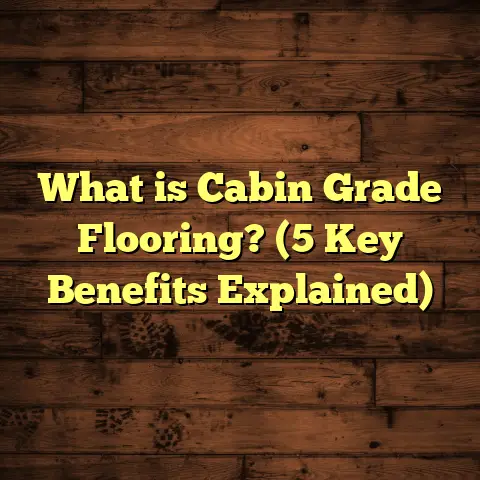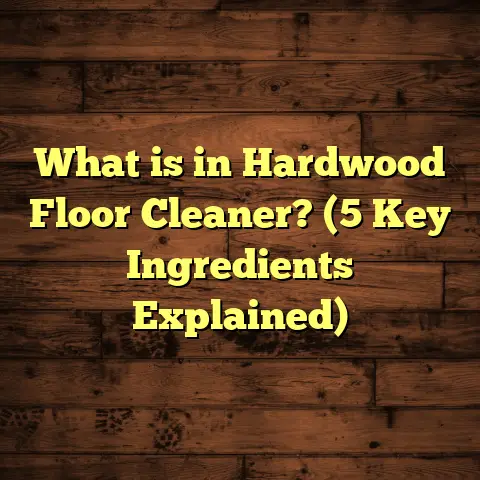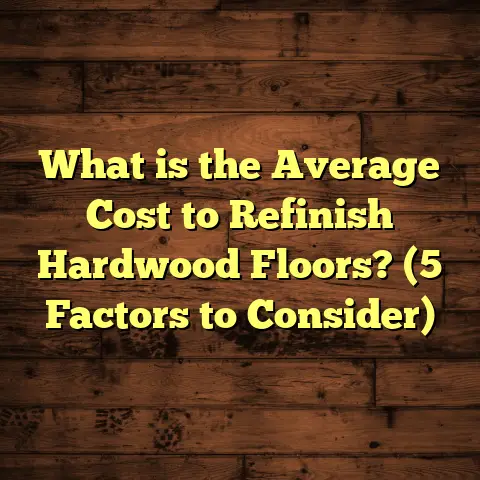What is Engineered Wood Flooring? (5 Key Materials Explained)
I remember watching an episode of Friends where Monica obsessively redoes her apartment’s flooring. She wanted something that looked great but could handle the wear and tear of everyday life. That scene stuck with me because it highlights how big a role flooring plays in our homes’ comfort and style. Over the years, as someone who’s installed countless floors, I’ve found engineered wood flooring to be a fantastic choice for many people—offering beauty, toughness, and versatility. If you’re curious about what makes this flooring type special and how it stacks up against other options, I’m here to walk you through everything I’ve learned.
What is Engineered Wood Flooring?
Let’s start with the basics: what is engineered wood flooring? At its core, engineered wood flooring is a hybrid wood product. It’s made by bonding several layers of wood together, usually with a real hardwood veneer on the surface. This veneer is a thin slice of genuine hardwood, giving you the natural look and feel of wood underfoot.
The layers beneath the veneer—called the core—can be made from various materials such as plywood, high-density fiberboard (HDF), softwood, or even bamboo. These layers are glued in a way that each layer’s grain runs perpendicular to the one below it, which adds strength and stability.
Why was engineered wood flooring invented? Traditional solid hardwood floors, while beautiful, tend to expand and contract with changes in humidity and temperature. This can cause warping, cupping, and gaps over time—especially in basements or kitchens where moisture levels fluctuate. Engineered wood solves this problem by creating a more dimensionally stable plank.
Think of it like plywood furniture versus solid wood furniture: plywood doesn’t warp as easily because of how it’s layered. The same principle applies here.
Why Does Engineered Wood Matter?
You may wonder why so many homeowners and professionals recommend engineered wood flooring these days. From my personal experience over more than a decade installing floors across different climates and building types, I’ve seen it perform remarkably well in places where solid hardwood would struggle.
For example, in humid coastal regions or cold climates with radiant heating systems — both places that traditionally challenge solid wood floors — engineered wood often outperforms by staying flat and intact. Plus, it tends to be more cost-effective and easier to install.
Now that you know what engineered wood flooring is fundamentally about, let’s get into the meat of the topic—five key materials used in its construction. Understanding these will help you make smarter choices whether you’re renovating your home or advising clients.
1. Plywood Core: The Workhorse of Engineered Wood
Plywood is by far the most common core material used in engineered wood flooring. It’s constructed from multiple thin layers (or “plies”) of wood veneer glued together with their grains running perpendicular to each other.
This cross-grain setup provides excellent stability against moisture and temperature changes. Each layer helps counteract the movement of the others, reducing the chance of warping or twisting.
Why I Prefer Plywood Core
In my projects, plywood-core engineered floors are my go-to recommendation for most residential properties. I’ve installed these floors for families in humid climates like Florida and Louisiana, and they’ve held up beautifully for over 10 years with minimal issues.
One memorable project was a beachside condo where solid hardwood wasn’t an option due to high humidity. The plywood core floors stayed flat during hurricane season without warping or buckling—a huge win for the client.
Technical Data
- Moisture Resistance: Plywood cores typically tolerate small moisture fluctuations up to about 12% relative humidity without damage.
- Thickness: Most plywood cores range between 6mm to 12mm.
- Market Share: Around 60% of engineered wood floors globally use plywood cores.
- Cost: Mid-range pricing that balances durability and affordability.
Environmental Impact
Plywood cores can be made from fast-growing softwoods like pine or fir, making them relatively sustainable when sourced responsibly.
2. High-Density Fiberboard (HDF) Core: Sleek and Stable
HDF is an engineered wood product made by compressing wood fibers with resin at extremely high pressure. This creates a dense, smooth core material that’s often thinner than plywood but still strong.
When I Use HDF Core
I typically recommend HDF-core engineered flooring when clients have height restrictions or want a smoother surface for click-lock installation systems. For example, in urban condos where ceiling heights are already low, HDF cores allow for thinner planks without compromising stability.
Pros and Cons of HDF Core
- Pros:
- Uniform density reduces weak points.
- Thin profile suits floating floor applications.
- Smooth surface ensures tight locking joints.
- Cons:
- Less moisture tolerant compared to plywood cores.
- Can swell if exposed to standing water for extended periods.
Data Points
- Thickness usually ranges from 6mm to 9mm.
- Typically found in mid-to-low price segments.
- Performs best in dry indoor environments.
Personal Anecdote
I once helped a client install HDF-core engineered flooring over radiant heat in a mountain cabin. Because HDF conducts heat evenly and remains dimensionally stable under temperature swings, this floor remained comfortable and stable through harsh winters.
3. Softwood Core: Traditional but Less Durable
Softwood cores use layers of softer woods like pine or fir as the core material instead of plywood or HDF. This method was more common decades ago.
When Softwood Core Makes Sense
I rarely recommend softwood cores for modern installations unless it’s for period restoration projects where historical accuracy is important.
Softwood is less dense than other core materials, making these floors softer but less dimensionally stable. They’re prone to denting and more sensitive to moisture.
Real-World Use Cases
A few years ago, I worked on restoring a Victorian-era home with original softwood core engineered floors. We matched materials closely to preserve authenticity. While beautiful, these floors require more careful maintenance and aren’t ideal for busy family homes today.
Technical Notes
- Lower density means more prone to warping.
- Usually found in budget-friendly engineered wood products.
- Veneer thickness often thinner compared to premium products.
4. Bamboo Core: The Green Alternative
Bamboo isn’t technically wood—it’s a grass—but it’s increasingly used as a core material due to its strength and rapid renewability.
Why Bamboo Core Appeals to Me
A client passionate about sustainability once asked me to install bamboo-core engineered flooring throughout their eco-friendly home. Bamboo grows faster than any hardwood species I know—some species mature in just 3-5 years compared to decades for oak or maple.
The bamboo core provided strong stability and great moisture resistance while aligning well with their green building goals.
Performance Insights
- Bamboo fibers provide natural hardness equivalent to some hardwoods.
- Highly resistant to moisture and temperature changes.
- Cost can be higher due to specialized manufacturing processes.
Case Study: Bamboo Core in Action
In a recent project with a green architecture firm, bamboo-core engineered flooring was chosen for an office space with large south-facing windows. The floor handled temperature swings without issues over two years, validating bamboo as an excellent core option beyond residential use.
5. Multi-Ply Mixed Wood Core: The Premium Choice
Some high-end engineered wood floors use multi-ply cores made from different types of woods layered strategically for maximum stability and durability.
Why Multi-Ply Cores Are Special
By combining different species or varying grain directions across layers, manufacturers create planks that resist expansion and contraction better than single-species cores.
I installed multi-ply engineered flooring in a luxury penthouse where temperature swings were extreme due to large glass walls. The floor remained flawless after several seasons—no gaps, no buckling.
Data Highlights
- Often found in premium products costing 20-30% more.
- Veneer thickness tends to be 4mm or greater, allowing multiple refinishes.
- Multi-ply construction extends floor lifespan by 25% on average compared to basic plywood cores.
How Does Engineered Wood Flooring Compare With Other Flooring Options?
If you’re weighing your choices between solid hardwood, laminate, vinyl plank, or tile, here’s how engineered wood stacks up based on my experience:
| Flooring Type | Durability | Moisture Resistance | Installation Flexibility | Cost Range | Refinishing Potential |
|---|---|---|---|---|---|
| Solid Hardwood | High | Low | Nail-down only | $$$ – $$$$ | Multiple times |
| Engineered Wood | Medium-High | Medium-High | Nail-down/Glue/Float | $$ – $$$ | Limited (depends on veneer thickness) |
| Laminate | Medium | Medium | Float | $ – $$ | None |
| Vinyl Plank | Medium | High | Float/Glue | $ – $$ | None |
| Tile | Very High | Very High | Glue/Thinset | $$ – $$$$ | N/A |
From my installations, engineered wood hits a sweet spot—offering natural beauty closer to hardwood but performing better under challenging conditions.
Installation Tips Based on My Experience
Getting your engineered wood floor installed right makes all the difference. Here are some insights I’ve picked up over thousands of square feet laid:
- Acclimate Before Installation: Let the planks sit in the room for at least 48 hours before installation to adjust to temperature and humidity.
- Use Proper Subfloor Prep: A clean, level subfloor prevents issues down the road.
- Choose Installation Method Wisely: Nail-down for wood subfloors; glue-down or floating for concrete slabs.
- Leave Expansion Gaps: Even engineered wood needs room to expand slightly.
- Hire Professionals if Unsure: DIY can save money but might risk voiding warranties if done improperly.
Maintenance and Care: Keeping Floors Looking Great
Engineered wood floors require less maintenance than solid hardwood but still need some care:
- Sweep or vacuum regularly to remove grit.
- Clean spills promptly with a damp cloth—avoid soaking water.
- Use manufacturer-recommended cleaning products.
- Place felt pads under furniture legs.
- Avoid harsh chemicals or abrasive scrubbers.
From my follow-ups with clients over years, those who maintain their floors well enjoy their beauty far longer without costly repairs or refinishing.
How I Use FloorTally for Budgeting My Jobs
When budgeting flooring projects—especially with multiple material options—I turn to FloorTally often. It lets me input room dimensions, preferred materials (including different core types), labor rates, and even waste factors.
For instance, one recent kitchen remodel involved comparing costs between plywood-core oak veneer and bamboo-core engineered flooring. FloorTally helped me quickly generate detailed estimates factoring local labor costs and material availability. It even helped me plan for extra materials needed due to cutting waste—something that can catch many installers off guard.
Clients appreciate seeing transparent cost breakdowns upfront too; it builds trust when you can show exactly where their money goes versus vague estimates.
What About Environmental Concerns?
If you care about sustainability like I do, engineered wood flooring offers some advantages:
- Uses less solid hardwood per plank than traditional hardwood floors.
- Many manufacturers source plywood cores from certified sustainable forests.
- Bamboo core options reduce reliance on slow-growing trees.
- Some brands offer recycled content options in HDF or fiberboard cores.
Always check for certifications like FSC (Forest Stewardship Council) or PEFC when shopping if environmental impact is important to you.
Common Issues I’ve Encountered With Engineered Wood Floors—and How To Avoid Them
Even though engineered wood performs well overall, no product is perfect. Here are some issues I’ve seen firsthand:
1. Delamination
This happens when layers separate due to prolonged moisture exposure or poor manufacturing quality. Avoid by choosing reputable brands and keeping water away from floors.
2. Gapping Between Planks
Can result from improper acclimation or installation without expansion gaps. Always acclimate flooring before install and follow manufacturer guidelines on spacing.
3. Scratches and Dents
While engineered floors have durable finishes, they’re not scratch-proof. Using area rugs in high traffic zones and furniture protectors helps prevent damage.
4. Fading from Sunlight
Direct sunlight may cause color changes over time. Using window coverings or UV-resistant finishes reduces this risk.
In My Opinion: Is Engineered Wood Flooring Worth It?
Absolutely yes—in most cases. It balances aesthetics with practicality like few other options can. Whether you’re renovating your family home or finishing a commercial space, understanding the core materials helps you pick the right product for your specific needs.
If you want floors that look real, last long, handle moisture better than solid hardwood, and don’t break the bank, engineered wood stands out as a smart choice.
FAQs from Clients I Often Hear
Q: How thick should the veneer be on an engineered wood floor?
A: Veneers usually range from 0.6mm to over 6mm thick. Thicker veneers (3mm+) allow multiple sanding cycles for longer life.
Q: Can I install engineered wood flooring over concrete?
A: Yes! Engineered wood is perfect for concrete slabs since it’s less prone to moisture-related warping than solid hardwood.
Q: How many times can I refinish an engineered floor?
A: Depends on veneer thickness—thin veneers (0.6mm) might not be sandable at all; thicker ones (3+mm) can be sanded 2-3 times over their lifespan.
Q: Is engineered wood flooring noisy?
A: If installed properly with underlayment, noise is minimal—often quieter than laminate floors.
Summary of Key Takeaways
- Engineered wood flooring consists of multiple layers with a real hardwood top veneer.
- Core materials vary widely (plywood, HDF, softwood, bamboo), affecting durability and moisture resistance.
- Plywood cores offer excellent stability; HDF cores suit thin-profile installations; bamboo cores appeal for eco-friendliness; softwood cores are less common today; multi-ply mixed cores provide premium performance.
- Installation methods include nail-down, glue-down, or floating techniques depending on subfloor conditions.
- Maintenance is straightforward but important for longevity.
- Tools like FloorTally help with accurate budgeting by accounting for materials, labor, waste, and local prices.
- Engineered wood balances beauty with practicality better than many other options available today.
If you ever want advice on selecting the right engineered wood floor or need help estimating costs realistically using tools like FloorTally, just ask! Flooring projects can seem overwhelming at first—but breaking them down into manageable parts makes them much easier—and more enjoyable—to handle.
Whether you lean toward classic oak plywood-core planks or innovative bamboo multi-ply boards, engineered wood flooring has proven itself time and again as a reliable choice that looks great and lasts long.
That’s my full take on engineered wood flooring after years of hands-on work and research! If any part sparks your curiosity or you want me to dig into specifics like finish types or installation methods next time, just let me know!





